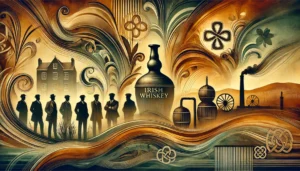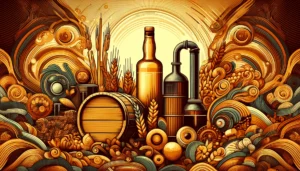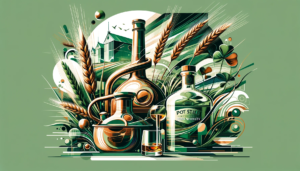Understanding Single Malt Irish Whiskey
Irish whiskey, with its rich history and diverse styles, has captivated connoisseurs and casual drinkers alike. Among its various forms, single malt Irish whiskey stands out as a particularly intriguing and sophisticated expression. In this exploration, we delve into the defining aspects of single malt Irish whiskey, a beverage steeped in tradition yet constantly evolving with modern tastes and techniques.
This article aims to provide an in-depth look at what specifically characterizes single malt Irish whiskey. We’ll journey through its production process, uncovering the meticulous steps and unique methods that give this whiskey its distinctive identity. From the selection of ingredients to the intricacies of distillation and aging, every element plays a crucial role in shaping the final product. We will also highlight the unique characteristics and flavor profiles that single malt Irish whiskey brings to the table, offering a sensory map for enthusiasts and newcomers alike.
As we explore, we’ll also touch upon the latest innovations and trends that are shaping the future of this beloved spirit. Whether you’re a seasoned whiskey aficionado or new to the world of Irish spirits, this article promises to deepen your appreciation and understanding of single malt Irish whiskey.
Defining Single Malt Irish Whiskey
Single malt Irish whiskey, often revered for its smoothness and complexity, is a product of meticulous craftsmanship and centuries-old traditions. What exactly defines this unique category of whiskey?

Origin and Definition
At its core, single malt Irish whiskey is made from 100% malted barley. The ‘single’ in its name signifies that the whiskey comes from one single distillery, ensuring a distinct character specific to its place of origin. Unlike its Scotch counterpart, Irish whiskey traditionally uses triple distillation, a process that contributes to its renowned smoothness.
Legal Standards
To be labeled as single malt Irish whiskey, the spirit must adhere to strict legal criteria. It must be distilled to an alcohol by volume (ABV) of less than 94.8%, ensuring that the flavors of the malt and the nuances of the distillation process shine through. Additionally, it must be aged in wooden casks, typically oak, for a minimum of three years in Ireland, further developing its flavor profile.
The Uniqueness of Irish Malting
A key distinguishing feature is the malting process. Irish whiskey traditionally uses unmalted barley, sometimes in combination with malted barley, to create a smoother, lighter flavor profile. This method dates back to historical tax laws but has since become a defining characteristic.
Triple Distillation
The triple distillation process is another hallmark of single malt Irish whiskey. This extra step of distillation, not always used in other whiskey traditions, removes more impurities and results in a higher purity spirit. It’s this process that imbues single malt Irish whiskey with its notably smooth and palatable character, often described as gentle yet complex.
The Role of Water
Water plays a crucial role, not just in the mashing and fermentation processes, but also in the final cut. The purity and mineral content of Irish water, often drawn from natural springs near the distilleries, contribute significantly to the final taste and quality of the whiskey.
In summary, single malt Irish whiskey is a product of its environment, ingredients, and the skilled hands that craft it. Its defining characteristics — from the use of malted barley to the triple distillation process and the influence of Irish water — combine to create a spirit that is both rich in history and flavor.
The Ingredients and Production Process of Single Malt Irish Whiskey
The production of single malt Irish whiskey is a dance of science and art, where each step and ingredient plays a critical role. Let’s explore the key components and processes that go into crafting this exquisite spirit.

Choice of Barley
The journey begins with barley, the soul of single malt Irish whiskey. Malted barley, germinated and dried, is preferred for its ability to convert starches into fermentable sugars. The choice of barley, including its variety and the conditions under which it’s grown, significantly impacts the flavor profile of the whiskey.
Malting Process
Malting is a delicate process involving soaking the barley in water and allowing it to germinate. This germination is halted by drying the grains in a kiln. In Ireland, peat is seldom used in the drying process, differentiating Irish whiskey with a lighter and fruitier profile compared to the often peaty Scotch.
Mashing and Fermentation
The malted barley is then ground into a grist and mixed with hot water in a mash tun. This process, known as mashing, extracts the sugars from the grains. The resultant liquid, called wort, is cooled and transferred to fermentation vessels where yeast is added. Yeast plays a vital role in converting the sugars into alcohol, a process that takes about 48 to 96 hours, resulting in a liquid known as wash, with low alcohol content.
Distillation
Distillation is where the magic happens. Irish whiskey is typically triple distilled in copper pot stills. Each distillation further purifies the spirit, enhancing its smoothness and subtlety. The shape and size of the pot stills also influence the character of the whiskey, with taller stills producing a lighter spirit.
Aging and Maturation
After distillation, the whiskey is aged in wooden casks, a process that profoundly influences its flavor. The interaction between the whiskey and the wood over several years imparts complexity and depth. The choice of casks—whether they are former bourbon, sherry, or wine barrels—adds distinct notes to the final product.
Water Quality
Finally, the quality of water used throughout the production process, especially in diluting the whiskey to the desired strength, is crucial. Irish distilleries often use natural spring or river water, which can add unique mineral qualities to the whiskey.
Through this intricate process, every batch of single malt Irish whiskey tells a story of its heritage, the land, and the skilled hands that crafted it. This traditional yet dynamic process continues to evolve, giving us a spirit that is both timeless and contemporary.
The Art of Distillation and Aging in Single Malt Irish Whiskey Production
The distillation and aging processes are where single malt Irish whiskey truly acquires its character and distinction. These stages are a blend of science, tradition, and artistry, each contributing significantly to the whiskey’s final taste and quality.

Distillation: Crafting Purity and Flavor
- Triple Distillation: Unlike most other whiskey traditions, Irish whiskey typically undergoes triple distillation. This process, carried out in copper pot stills, results in a purer, smoother spirit. The copper interacts with the whiskey, removing sulfurous compounds and other impurities, thereby enhancing the final flavor.
- The Role of Pot Stills: The design of the pot stills, often bespoke and varying from one distillery to another, plays a crucial role in shaping the whiskey’s character. Taller stills with longer necks produce a lighter, more refined spirit, while shorter stills yield a richer, fuller-bodied whiskey.
Aging: The Transformation into Complexity
- The Influence of Wood: After distillation, the spirit is aged in wooden casks, a process that is as much an art as it is a science. The interaction between the whiskey and the wood over time allows for the absorption of complex flavors from the cask. This aging process is responsible for adding distinct notes such as vanilla, caramel, spice, and fruit.
- Cask Selection: The choice of casks is pivotal. Ex-bourbon barrels, sherry butts, and wine casks are among the popular choices, each imparting unique flavors to the whiskey. Some distilleries also experiment with finishing the whiskey in barrels that previously held other spirits or wines, adding layers of complexity.
The Impact of Time and Environment
- Aging Period: The duration of aging is a key factor in the development of the whiskey’s flavor profile. The longer the whiskey matures, the more complex it becomes, though this also depends on the interaction between the whiskey, the wood, and the environment.
- Warehouse Conditions: The conditions in the aging warehouse, such as temperature and humidity, significantly affect the aging process. In Ireland’s mild, damp climate, the whiskey matures in a way that accentuates its smoothness and richness.
Through these meticulous processes of distillation and aging, single malt Irish whiskey transforms from a clear, potent spirit into a nuanced and sophisticated beverage. This transformation, underpinned by centuries of tradition and the skill of the distillers and blenders, is what makes single malt Irish whiskey a celebrated and cherished spirit worldwide.
Unique Characteristics and Flavor Profiles of Single Malt Irish Whiskey
Single malt Irish whiskey is renowned for its distinctive characteristics and diverse flavor profiles. This section delves into the sensory qualities that make this whiskey a standout choice for enthusiasts and connoisseurs alike.

The Spectrum of Flavors
- Fruity and Floral: Many single malts from Ireland are noted for their light, fruity, and floral notes. These can range from green apple and pear to hints of citrus and tropical fruits. Floral undertones often accompany these fruit flavors, adding to the whiskey’s freshness and lightness.
- Spice and Wood: As the whiskey matures in oak barrels, it develops rich notes of vanilla, caramel, and toffee. These sweet and creamy flavors are often balanced by a hint of spice — think nutmeg, cinnamon, or pepper — adding depth and complexity.
- Earthy and Peaty: While less common in Irish whiskeys compared to their Scottish counterparts, some single malts do exhibit a subtle peatiness or earthiness. These characteristics bring a smoky dimension to the whiskey, adding to its richness.
Texture and Mouthfeel
- Smooth and Velvety: One of the hallmark features of single malt Irish whiskey is its smoothness. This is largely attributed to the triple distillation process, which results in a spirit that is both pure and silky in texture.
- Creamy and Full-bodied: Some single malts, especially those aged for longer periods or in specific types of casks, can have a creamy, full-bodied mouthfeel. This texture makes the whiskey particularly enjoyable to savor and sip.
The Influence of Aging and Cask Type
- Cask Finish Variations: The type of cask used for aging plays a significant role in defining the whiskey’s final flavor profile. For instance, whiskey aged in sherry casks might exhibit rich, dried fruit and nutty flavors, while bourbon cask aging imparts sweet, vanilla, and oak notes.
- Aging Period Impact: The duration of aging also affects the flavor. Longer aging allows for more interaction between the whiskey and the wood, often resulting in a more complex and nuanced flavor profile.
In conclusion, single malt Irish whiskey offers a diverse and intricate flavor landscape. Its wide range of profiles caters to a variety of palates, making it a versatile and appealing choice for whiskey lovers around the world.
Innovations and Trends in Single Malt Irish Whiskey Production
The world of single malt Irish whiskey is not just rooted in tradition but is also at the forefront of innovation. This section highlights how contemporary trends and technological advancements are shaping the future of this storied spirit.

Embracing New Technologies
- Advanced Distillation Techniques: Modern distilleries are experimenting with cutting-edge distillation methods to refine flavors and create more sustainable production processes. Innovations in still design and temperature control are allowing distillers to craft spirits with greater precision and consistency.
- Data-Driven Maturation: Some distilleries are employing data analytics to better understand the maturation process. Sensors and monitoring systems in warehouses provide valuable insights into how different environmental factors affect the aging whiskey.
Experimental Cask Aging
- Diverse Cask Selection: There’s a growing trend of aging whiskey in a variety of casks beyond the traditional oak. Experimentation with wine, rum, or even exotic wood casks is producing unique flavor profiles, pushing the boundaries of what Irish whiskey can be.
- Finish and Double Maturation: The practice of finishing whiskey in a second type of cask after initial maturation is becoming increasingly popular. This technique adds layers of complexity and allows for the infusion of distinct flavors from the second cask.
Sustainable and Local Sourcing
- Eco-friendly Practices: Sustainability is becoming a key focus. Distilleries are investing in renewable energy sources and looking at ways to reduce water usage and carbon footprint.
- Local Ingredient Sourcing: There’s a renewed emphasis on sourcing ingredients locally, including barley and water. This not only supports local communities but also ensures the whiskey embodies a true sense of its Irish origin.
Craft and Small-Batch Production
- Rise of Craft Distilleries: The Irish whiskey landscape is witnessing a surge in craft and artisanal producers. These smaller distilleries are often more agile, enabling them to experiment with different styles and production methods.
- Limited Edition Releases: Limited edition and small-batch releases are becoming more common. These offer whiskey enthusiasts exclusive and often innovative expressions, further enriching the whiskey-tasting experience.
In conclusion, while single malt Irish whiskey is deeply rooted in tradition, it is also a dynamic and evolving category. These innovations and trends demonstrate a vibrant industry that respects its past while eagerly embracing the future, promising exciting developments for whiskey lovers worldwide.
Conclusion: The Enduring Appeal of Single Malt Irish Whiskey
As we conclude our exploration of single malt Irish whiskey, it’s clear that this storied spirit is a remarkable blend of history, craftsmanship, and innovation. From the careful selection of barley to the art of distillation and aging, each step in the production process is a testament to the dedication and skill of Irish distillers. The unique flavor profiles, ranging from light and fruity to rich and complex, cater to a diverse array of palates, making single malt Irish whiskey a beloved choice for many.
The recent trends in innovation and sustainability are not just exciting for the industry; they also promise a future where tradition and modernity coexist harmoniously. These developments ensure that single malt Irish whiskey will continue to captivate and delight enthusiasts around the world, maintaining its position as a cherished symbol of Irish heritage.
As you enjoy a glass of single malt Irish whiskey, remember that you’re not just savoring a fine spirit, but also a piece of Ireland’s rich history and its vibrant present. Whether you’re a longtime aficionado or a curious newcomer, the world of single malt Irish whiskey offers a journey of discovery, one that’s as rewarding as it is flavorful.












Be First to Comment